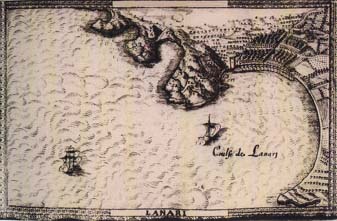onMouseOver="onPic('languePic');" onMouseOut="offPic('languePic');">
More of history?
Consult:
Emblem
the history of Sanary
The tower of Sanary
The harbor of Sanary
1688: Victory and joy
1707: Twenty-two
ships in roadstead
1789: The revolution
1859: The first train
XXth century
1923: Sanary on sea

From the XIth century, the old titles Saint-Victor's monks, of Marseille, signal it «Cellam Sancti Nazarii».
Around this one come to group some fishers and agrarians of Ollioules of whom depend the soil, under the suzerainty of Viscounts of Marseille and Simiane.
Certainly, this aren't the first inhabitants of our shore. Already, celtoligure village of the Garou is dated 600 before J.C., some Gallo-Roman cities are identified at Portissol, at the Gorguette. A few everywhere, remnants of doila, of tegulas, strew soil. In 1882, at Portissol, twenty tombs are discovered; recently, one put up to date a potter's oven. Currencies of Claude, of Adrien, of Vespasien has been found. A stele has been discovered near the Reppe. A long time ago that the man leave traces of his habitat on our soil. Can we think that inhabitants of the Courtine, so close of the sea side, didn't come to see what's going there ?
Around this one come to group some fishers and agrarians of Ollioules of whom depend the soil, under the suzerainty of Viscounts of Marseille and Simiane.
Certainly, this aren't the first inhabitants of our shore. Already, celtoligure village of the Garou is dated 600 before J.C., some Gallo-Roman cities are identified at Portissol, at the Gorguette. A few everywhere, remnants of doila, of tegulas, strew soil. In 1882, at Portissol, twenty tombs are discovered; recently, one put up to date a potter's oven. Currencies of Claude, of Adrien, of Vespasien has been found. A stele has been discovered near the Reppe. A long time ago that the man leave traces of his habitat on our soil. Can we think that inhabitants of the Courtine, so close of the sea side, didn't come to see what's going there ?
But it is especially from the XIVth century that starts the beginning of what is going to be first a hamlet, then a borough. In a supplication to the King, syndics of inhabitants of Saint-Nazaire-les-Ollioules make know what follows: «The place of Oliolis has a big and spacious soil that succeeds in various places to the shore of the sea where there's two harbors, in one of them the Lords of the place having a so big popularity of their old fief and domain in the district Saint-Nazaire, that they made built to the edge of the harbor a very strong and considerable tower... », (the date of construction of the Roman tower is 1300). These two harbors are Lagoubran, finishes to the top, and Saint-Nazaire, finishes it of its bottom.
This is how they call these soils.
In 1436, the risk of a barbarian's attacks incited the King René to order to Oliolis, against certain privileges, to reinforce defenses of Saint-Nazaire in these terms: «Being given that the borough of Saint-Nazaire depend on Oliolis, the King René order Oliolis to make the boulevard and ditch to the Saint-Nazaire's tower... ». This act is dated of July 1st, 1436. The tower had already been reloaded in 1323, after the visit of Robert of Millet, ruler of Provence.
We sees - by the change of the designation of the agglomeration that we calls dwellings, hamlet, successively then borough - an evolution in the number of houses, therefore of the population. Later, we will see this evolution amplifying itself, notably in 1507. That year, the Lord Bertrand of Ventimille and his cousin, Guirans of Simiane, all two co-Lords, grant earths to sixteen new families coming to increase the number of inhabitants. Some of these newcomers will be allowed to build on the boulevard of the tower, inside ditches. One year before, they also conceded to Chautard of Ollioules lands situated to Mortier and underhand of the path that conducted to the Gorguette.
This is how they call these soils.
In 1436, the risk of a barbarian's attacks incited the King René to order to Oliolis, against certain privileges, to reinforce defenses of Saint-Nazaire in these terms: «Being given that the borough of Saint-Nazaire depend on Oliolis, the King René order Oliolis to make the boulevard and ditch to the Saint-Nazaire's tower... ». This act is dated of July 1st, 1436. The tower had already been reloaded in 1323, after the visit of Robert of Millet, ruler of Provence.
We sees - by the change of the designation of the agglomeration that we calls dwellings, hamlet, successively then borough - an evolution in the number of houses, therefore of the population. Later, we will see this evolution amplifying itself, notably in 1507. That year, the Lord Bertrand of Ventimille and his cousin, Guirans of Simiane, all two co-Lords, grant earths to sixteen new families coming to increase the number of inhabitants. Some of these newcomers will be allowed to build on the boulevard of the tower, inside ditches. One year before, they also conceded to Chautard of Ollioules lands situated to Mortier and underhand of the path that conducted to the Gorguette.
 The harbor, that sees the construction of a first embankment come to be added to the near jetty of the tower, becomes important. It becomes more frequented, but its weak depth, its silting up by the river, the Reppe, will always be harmful to it. A big part of the population lives from the sea: sinners, navigators for the Echelles du Levant (Ladders of Rising) and, with time, farther more, toward America and Terre-Neuve.
The harbor, that sees the construction of a first embankment come to be added to the near jetty of the tower, becomes important. It becomes more frequented, but its weak depth, its silting up by the river, the Reppe, will always be harmful to it. A big part of the population lives from the sea: sinners, navigators for the Echelles du Levant (Ladders of Rising) and, with time, farther more, toward America and Terre-Neuve.Alas, Saint-Nazaire has pain to develop itself so much that it is bound to Ollioules. Also, as the trade develops itself, born a middle class of merchants, some more enterprising notables appears. The population, is certain to have the power to manage herself. Ollioules will be obliged to admit syndics to Saint-Nazaire, that will come to sit to the Council of the Community. These Syndics, the Bernard, Infernets, of Saint-Maurice, will open out the biggest efforts in requests, of suits, of interventions close to the Parliament of Provence, at Aix, that to the court of France. They want to get their autonomy, of as much more that in various other townships, some similar facts are going to occurs and so reinforce them in their hope.
It is la Seyne that, in 1657, gets to part with Six-Fours, la Ciotat, in 1675, separate of Ceyreste. All boroughs of the earth inside see their dependences of the sea side, become surer, to part with the common mother. It cannot be different for Ollioules and Saint-Nazaire.
Several suits in separation are going to be instituted against Ollioules. In 1649, 1673, and 1678.
Always in pure loss and well often with threats of repression. However, many advantages are gotten from Ollioules that understands that it needs to make some concessions. This is how we gets a fountain, a bench of butcher shop, a local herd and some other improvements, like a Lieutenant of the judge of Ollioules. But nothing there made and we understands the bitterness of Ollioules that, in spite of its efforts of understanding, feels Saint-Nazaire to escape them. It senses that its economic life will be a little bit disrupted, especially by the loss of the harbor. It was by it that make themselves exports of their production, by it that the important commodities came. That's already arrived time ago, in 1225, in a dispute with Toulon for Lagoubran. Later also, in 1296, Evenos parted from Ollioules.